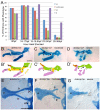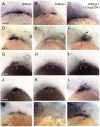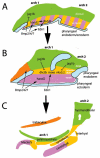Combinatorial roles for BMPs and Endothelin 1 in patterning the dorsal-ventral axis of the craniofacial skeleton
- PMID: 22031543
- PMCID: PMC3210495
- DOI: 10.1242/dev.067801
Combinatorial roles for BMPs and Endothelin 1 in patterning the dorsal-ventral axis of the craniofacial skeleton
Abstract
Bone morphogenetic proteins (BMPs) play crucial roles in craniofacial development but little is known about their interactions with other signals, such as Endothelin 1 (Edn1) and Jagged/Notch, which pattern the dorsal-ventral (DV) axis of the pharyngeal arches. Here, we use transgenic zebrafish to monitor and perturb BMP signaling during arch formation. With a BMP-responsive transgene, Tg(Bre:GFP), we show active BMP signaling in neural crest (NC)-derived skeletal precursors of the ventral arches, and in surrounding epithelia. Loss-of-function studies using a heat shock-inducible, dominant-negative BMP receptor 1a [Tg(hs70I:dnBmpr1a-GFP)] to bypass early roles show that BMP signaling is required for ventral arch development just after NC migration, the same stages at which we detect Tg(Bre:GFP). Inhibition of BMP signaling at these stages reduces expression of the ventral signal Edn1, as well as ventral-specific genes such as hand2 and dlx6a in the arches, and expands expression of the dorsal signal jag1b. This results in a loss or reduction of ventral and intermediate skeletal elements and a mis-shapen dorsal arch skeleton. Conversely, ectopic BMP causes dorsal expansion of ventral-specific gene expression and corresponding reductions/transformations of dorsal cartilages. Soon after NC migration, BMP is required to induce Edn1 and overexpression of either signal partially rescues ventral skeletal defects in embryos deficient for the other. However, once arch primordia are established the effects of BMPs become restricted to more ventral and anterior (palate) domains, which do not depend on Edn1. This suggests that BMPs act upstream and in parallel to Edn1 to promote ventral fates in the arches during early DV patterning, but later acquire distinct roles that further subdivide the identities of NC cells to pattern the craniofacial skeleton.
Figures








References
-
- Aberg T., Wozney J., Thesleff I. (1997). Expression patterns of bone morphogenetic proteins (Bmps) in the developing mouse tooth suggest roles in morphogenesis and cell differentiation. Dev. Dyn. 210, 383–396 - PubMed
-
- Aybar M. J., Mayor R. (2002). Early induction of neural crest cells: lessons learned from frog, fish and chick. Curr. Opin. Genet. Dev. 12, 452–458 - PubMed
-
- Beverdam A., Merlo G. R., Paleari L., Mantero S., Genova F., Barbieri O., Janvier P., Levi G. (2002). Jaw transformation with gain of symmetry after Dlx5/Dlx6 inactivation: mirror of the past? Genesis 34, 221–227 - PubMed
-
- Bouallegue A., Daou G. B., Srivastava A. K. (2007). Endothelin-1-induced signaling pathways in vascular smooth muscle cells. Curr. Vasc. Pharmacol. 5, 45–52 - PubMed
Publication types
MeSH terms
Substances
Grants and funding
LinkOut - more resources
Full Text Sources
Molecular Biology Databases
Miscellaneous

